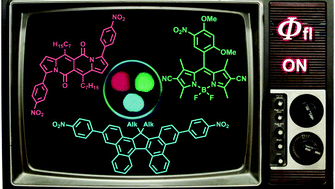Revisiting the non-fluorescence of nitroaromatics: presumption versus reality
Abstract
The electronically excited singlet states of nitroaromatic compounds are often presumed to be essentially non-fluorescent. Nonetheless, a growing number of reports in the literature have demonstrated that certain structural types of nitroaromatics can indeed fluoresce, and often quite efficiently. Consideration of the mechanisms responsible for the typical fast or ultrafast non-radiative deactivation of the excited singlet states of nitroaromatics points to several general principles for their design that combine the strong electron-withdrawing properties of the nitro group with reasonable fluorescence quantum yields. An overview of published examples of fluorescent nitroaromatics emphasizes these concepts in the context of the importance of chromophore architecture and conformation and the defining roles of excited state charge transfer and solvent polarity in modulating the non-radiative decay channels that compete with fluorescence. Overcoming the stigma that nitroaromatics are intrinsically destined to be non-fluorescent thus paves the way for incorporating the strongly electron-withdrawing nitro group into the existing toolbox for the development of new nitro-substituted fluorophores and chromophores tuned to specific applications.



 Please wait while we load your content...
Please wait while we load your content...